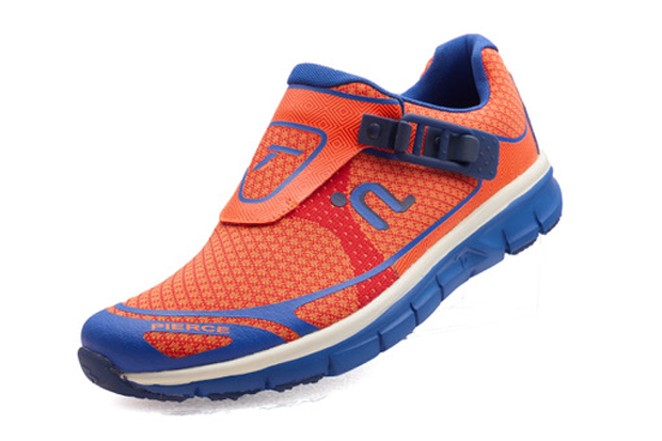On May 14, the Trump Administration announced a proposal to restrict imports to the U.S. on $300 billion in Chinese goods—including higher tariffs against shoe imports. Soon after, more than 170 of the nation's largest footwear companies—including Nike, Adidas and Converse—sent a letter to The White House warning of the "catastrophic" effects the proposed tariffs would have on companies, consumers and the economy.
"We can assure you that any increase in the cost of importing shoes has a direct impact on the American footwear consumer," the groups wrote in a letter published at Footwearnews.com, an industry publication. "It is an unavoidable fact that as prices go up at the border due to transportation costs, labor rate increases or additional duties, the consumer pays more for the product."
The Trump Administration proposal has some local business owners concerned.
Pierce Footwear, a Bend-based company that's been designing performance running shoes since 2014, has its products manufactured in China, according to CEO and Founder, George Pierce. Pierce told the Source that if the tariffs go into effect, many companies in the industry will move production to countries that have an experienced workforce and established materials ecosystems, but with little or no tariffs.
Most imports from Korea, for example, enter the U.S. with no duty or import processing fee—which stems from the 2012 Korean Free Trade Agreement, according to U.S. Customs and Border Protection.
"We look at Korea with high shoemaking history and no import duties as well as Vietnam with established production facilities," Pierce said. "We continue to formulate plans for Bend production in some ways."
According to the American Apparel and Footwear Association, 98 percent of all shoes, clothes, fashion accessories and travel goods sold in the U.S. are imported. The Footwear Distributors and Retailers of America estimates the proposed tariffs would tack on an additional $7 billion in annual costs for customers, on top of an existing $3 billion in tariffs paid by the shoe industry, which stem from legislation in 1930 intended to protect U.S. manufacturing during the Great Depression.
“It is time for the USA to redefine the shoe manufacturing industry with more than just 3D printing,” Pierce said. “Innovation in glue-less assembly, automated stitching, water based screening and 100 percent recycled footwear are investable technologies with environmental benefits.” —George Pierce
tweet this
The FDRA said many retailers have begun to map out costs for 2020 and some of its members are worried the new tariffs will put them out of business. The industry group said if the tariffs kick in, consumers would feel it almost immediately, which could affect holiday sales and back-to-school inventory.
"Big box retail with very cheap kids shoes will see a price increase to consumers eliminating the $20 throw-away kids models," Pierce said. "Consumers will look for better quality footwear, look to buy more local or U.S. products, as a backlash to China pricing. Since China produces 80 percent of the shoes imported to the USA, this has a major impact on all retailers."
According to industry groups, the shoe industry is deeply entrenched in China. Nearly 75 percent of imports come from Chinese manufacturing—and can't simply move factories to adjust to these tariffs, according to the AAFA.
The current trade war with China started in 2017 after the U.S. launched an investigation into Chinese trade practices, then slapped tariffs on billions of dollars' worth of Chinese goods. The Trump Administration said, "Imposing tariffs incentivizes companies to move production back to the U.S.," according to Footwear News.
Pierce said moving manufacturing back to the U.S. won't happen overnight, due to the complexities of making footwear, which depend on multiple layers of suppliers.
"However, it does continue to drive companies like Pierce Footwear to figure out how to build a 100 percent recycled shoe in Bend," Pierce said.
Pierce said stitching is half of the shoemaking cost and that automation of the process has already begun in the U.S.—which ultimately could produce the breakthrough needed for localized production.
"Shoe manufacturing in Bend would drive economic benefits for many other local Bend sports product companies that require sewing, dye cutting, injection molding and glue-less assembly," Pierce said.
Manufacturing shoes in the U.S. isn't out of the question right now, either.
Danner, one of Oregon's shoe icons, manufactures one-third of its shoes in the 59,000-square-foot factory that opened in 2012 in Northeast Portland, according to a story on Oregonlive.
"It is time for the USA to redefine the shoe manufacturing industry with more than just 3D printing," Pierce said. "Innovation in glue-less assembly, automated stitching, water based screening and 100 percent recycled footwear are investable technologies with environmental benefits.
"With a comprehensive smart footwear strategy backed by government and private equity investors, the U.S. can regain its innovative and environmental leadership in shoe making so that it is a net exporter to the world."
President Trump is expected to meet with Chinese President Xi Jinping during the G20 Summit June 28 to 29 in Osaka, Japan, to try to work out an end to the trade war.






















